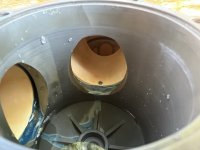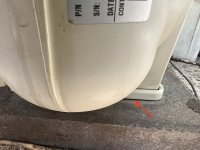I am in the process of trying to winterize my pool (midwest location) now that the season is over. During this process I wanted to test that I am able to airlock the main drain via air compressor hooked up to the pump inlet drain port and diverter valve blocking off the skimmer. After letting the air bubble up from the main drain, I set the diverter valve to block off the main drain. Unfortunately, it seems the diverter valve is not sealing well enough, and it doesn't maintain pressure to hold the airlock.
I first became suspicious of the diverter valve earlier in the season when I attempted to block off the skimmer to only use the main drain, and it started pulling air into the pump (water level was below skimmer level at the time).
I've ordered a new diverter valve assembly to swap over the guts, including the valve, but this didn't seem to resolve the issue.
Pool specifications:
I attempted to buy a rubber plug with blow-through valve stem to hopefully install from within the diverter valve body, but the tapered plug wouldn't clear the elliptical cutout on the inside of the diverter valve port. I found a non-tapered plug, but haven't tried one since they don't have a valve that will maintain the pressure.
Does anyone have any suggestions to save me from having to frantically dig up and cut out the diverter valve before winter?
Thanks!


I first became suspicious of the diverter valve earlier in the season when I attempted to block off the skimmer to only use the main drain, and it started pulling air into the pump (water level was below skimmer level at the time).
I've ordered a new diverter valve assembly to swap over the guts, including the valve, but this didn't seem to resolve the issue.
Pool specifications:
- ~12,000 Gal. Inground pool
- Fiberglass walls with concrete bottom
- ~20 years old
- Main drain diverter valve is just off the ground, so replacing it would require digging and cutting.
- There is now 1-2 screws that are stripped out on the valve body that attaches the top plate (this happened after I was swapping parts over and over, but the inability to seal was present prior to stripping these two out).
I attempted to buy a rubber plug with blow-through valve stem to hopefully install from within the diverter valve body, but the tapered plug wouldn't clear the elliptical cutout on the inside of the diverter valve port. I found a non-tapered plug, but haven't tried one since they don't have a valve that will maintain the pressure.
Does anyone have any suggestions to save me from having to frantically dig up and cut out the diverter valve before winter?
Thanks!








